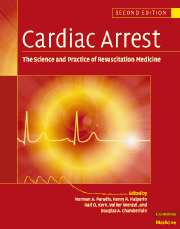Book contents
- Frontmatter
- Contents
- List of contributors
- Foreword
- Preface
- Part I Introduction
- Part II Basic science
- Part III The pathophysiology of global ischemia and reperfusion
- 12 The etiology of sudden death
- 13 Global brain ischemia and reperfusion
- 14 Reperfusion injury in cardiac arrest and cardiopulmonary resuscitation
- 15 Visceral organ ischemia and reperfusion in cardiac arrest
- 16 Mechanisms of forward flow during external chest compression
- 17 Hemodynamics of cardiac arrest
- 18 Coronary perfusion pressure during cardiopulmonary resuscitation
- 19 Methods to improve cerebral blood flow and neurological outcome after cardiac arrest
- 20 Pharmacology of cardiac arrest and reperfusion
- 21 Analysis and predictive value of the ventricular fibrillation waveform
- 22 Etiology, electrophysiology, and myocardial mechanics of pulseless electrical activity
- Part IV Therapy of sudden death
- Part V Postresuscitation disease and its care
- Part VI Special resuscitation circumstances
- Part VII Special issues in resuscitation
- Index
22 - Etiology, electrophysiology, and myocardial mechanics of pulseless electrical activity
from Part III - The pathophysiology of global ischemia and reperfusion
Published online by Cambridge University Press: 06 January 2010
- Frontmatter
- Contents
- List of contributors
- Foreword
- Preface
- Part I Introduction
- Part II Basic science
- Part III The pathophysiology of global ischemia and reperfusion
- 12 The etiology of sudden death
- 13 Global brain ischemia and reperfusion
- 14 Reperfusion injury in cardiac arrest and cardiopulmonary resuscitation
- 15 Visceral organ ischemia and reperfusion in cardiac arrest
- 16 Mechanisms of forward flow during external chest compression
- 17 Hemodynamics of cardiac arrest
- 18 Coronary perfusion pressure during cardiopulmonary resuscitation
- 19 Methods to improve cerebral blood flow and neurological outcome after cardiac arrest
- 20 Pharmacology of cardiac arrest and reperfusion
- 21 Analysis and predictive value of the ventricular fibrillation waveform
- 22 Etiology, electrophysiology, and myocardial mechanics of pulseless electrical activity
- Part IV Therapy of sudden death
- Part V Postresuscitation disease and its care
- Part VI Special resuscitation circumstances
- Part VII Special issues in resuscitation
- Index
Summary
Pulseless electrical activity (PEA) is defined in this chapter based on its clinical presentation, the presence of organized electrical activity, and the absence of detectable pulses. This definition includes any pulseless organized rhythm irrespective of etiology, heart rate, or electrocardiogram (ECG) characteristics.
PEA may be viewed as a continuous mechanical and electrical phenomenon. Detectable pulses may be lacking because of the absence of synchronous myocardial fiber shortening. Detectable pulses may also be absent in the presence of weak myocardial contractions that produce measurable aortic pressures as evidenced by invasive monitoring. PEA can also be present with normotensive cardiac activity in patients with conditions such as cardiac tamponade, hypovolemic shock, or severe peripheral arteriovascular disease.
There is evidence to support the contention that the ECG characteristics in PEA reflect the degree of pathophysiologic derangement or time from onset of cardiac arrest. Irrespective of PEA etiology, the more normal the ECG complex and the shorter the time from cardiac arrest, the higher is the likelihood of successful resuscitation or survival. Conversely, the more abnormal the ECG complex, the longer time from cardiac arrest and the lower the likelihood of successful resuscitation or survival. There probably has been no greater advance in understanding and managing PEA than the recent determination of a relationship between the integrity of the ECG complex and underlying mechanical activity.
Pulseless electrical activity is classified by its clinical presentation into three groups: (a) normotensive PEA, (b) pseudo-PEA, and (c) true PEA.
- Type
- Chapter
- Information
- Cardiac ArrestThe Science and Practice of Resuscitation Medicine, pp. 426 - 446Publisher: Cambridge University PressPrint publication year: 2007
- 5
- Cited by

